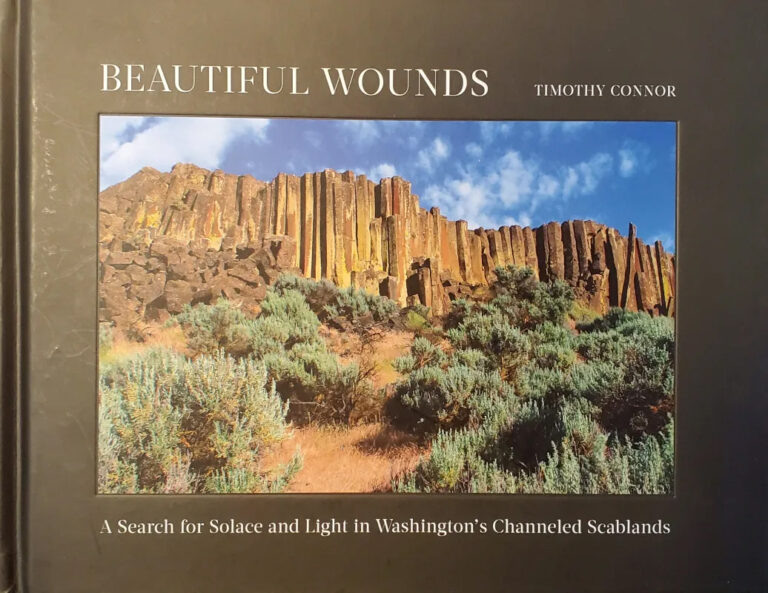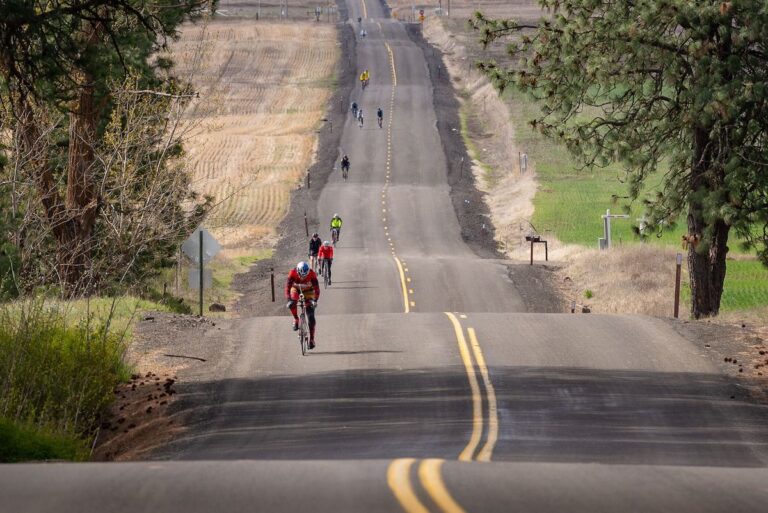In the cool of evening on Saturday night, March 29,2014, six of us, all senior Spokane Mountaineers, left our hotel rooms for a 20-minute walk through the winding resort village of Courmayeur, Italy, to the Cinema Palanoir. Cinema Palanoir is the main theater in the Aosta Valley and a beautiful architectural complement to the hanging glaciers thousands of feet above on Mont Blanc. The entrance to the theater is a giant, glass-shaped blooming tulip 60 feet high that is supported by a steel frame. Inside the Cinema was the seventh Spokane Mountaineer that we came to support and see honored as one of the world’s best mountaineers.
Two hundred-and-fifty-four years ago, the sport of mountaineering began on the other side of Mont Blanc in the village of Chamonix, France. The “producer” of mountaineering was a man named Benedict de Saussure, who in 1760, offered a cash reward for any man who could climb Mont Blanc. Twenty-six years later, in 1786, and climbing from Chamonix, Jaques Balmat and Dr. Michael Paccard claimed the prize and became the first men to stand on the summit of Mt. Blanc, 15,781 feet above sea level. Modern-day guides earn their money by successfully getting their clients up and down safely, but the money de Saussure paid Balmat and Paccard, as far as I know, is the first and last prize money won by mountaineers for reaching the summit of a mountain. The sport of alpinism was born, and with it emerged a new approach to the mountains and a new culture deeply rooted in the ethical and humanist values, which are more and more essential to our world today.
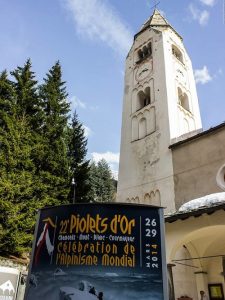
In 1965, a 7 ½ mile car tunnel that bored through Mont Blanc was completed thanks to the astounding engineering prowess of the Swiss, Italians, and French, thus joining Chamonix on the north side to Courmayeur, Italy, on the south side. Courmayeur is the smaller of the two villages, at just over 4,000 feet in elevation, and is nestled into a Pleistocene glacial-carved valley beneath wild rock pillars and hanging ice on the south side of Mont Blanc. These two villages set the scene for the 22nd Piolets d’Or awards for alpinism, the Academy Awards for the world’s greatest mountaineers. On March 27 and 28, we were entertained in Chamonix in the main conference theater at the luxurious Le Majestic Hotel of Chamonix. We watched climbing movies and learned about the celebrated climbers who represented the five climbs nominated for the 2014 Piolets d’ Or (The Golden Axe). The crowning prize was the Lifetime Achievement Award to be awarded to John Roskelley.
The third and final day of ceremonies was held in Courmayeur. The festivities started at the Alpine Museum on the hill above the Cinema Palanoir. There was a band dressed in colorful, native regalia, and at 6:30 sharp, the parade started through town with the band leading the way. The alpine guides followed, and then the rock stars of the year. Ueli Steck, Catherine Destivelle and George Lowe were walking with the eight climbers nominated for this year’s most inspiring climb. I had heard about how popular climbers were in Europe, but to see the respect paid for their achievements was stunning.
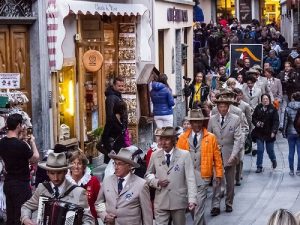
The parade moved south through the main street of Courmayeur for about six blocks, then did a U-turn back north toward the theater. As we entered the front doors of the theater, Ueli Steck, the superstar mountaineer of the day, was chatting with Catherine Destivelle and the Mayors of Chamonix and Courmayeur. I thought my wife Michelle was going to do a table dance as she snapped photos of the super fit Ueli Steck. Inside the large foyer to the theater, music played for the invited guests including climbers, mayors, and judges. We had a smorgasbord of the finest hor d’oeuvres offered in Europe that included fondue cheeses and breads, vegetables, lamb, wine and beers. After nearly two hours of filling our stomachs, we filed into the theater.
The main event started as the master of ceremonies, the beautiful Kay Rush, walked onto the stage dressed in a brown sweater and a slim, silver skirt with silver slippers. Kay introduced the climbers for the five nominated climbs and expeditions. Kay asked the questions to the climbers in English and translated the answers in Italian. The first nominated climb was shown on the big screen in a prepared video describing the commitment and ascent, with the climbers standing on stage watching the screen. The guides stood by on the outside of the stage dressed in professional grey tweed suits.
In between the nominated climbs, the Italian band l’orage performed on stage with a host of instruments, ranging from flutes, harmonicas, Scottish bagpipes, to a double bass, entertaining the audience with Italian songs. I couldn’t understand a word but wanted to get up and dance anyway. On a giant screen behind the musicians a video of mountain scenes played, complementing the music. An acrobat danced across the stage as the band played. All this pomp for mountain climbers! For the record, Kay never asked the classic question: why do you climb mountains?
After the five nominated climbs, Kay Rush began her speech to present the Lifetime Achievement Award to John Roskelley. With Mount Spokane the highest inspirational mountain in view of our city, how did a desert town like Spokane cultivate one of the world’s greatest alpinists? The packed theater of approximately 700 people was curious to learn. John explained in a prepared video shown on a giant screen how he got started in the Spokane Mountaineers club. He explained how friends and family and human values of shared kinship of the rope were the most important things in life. He talked about and showed in slides the expeditions that were most important to him. His track record of success in the mountains was undeniable.
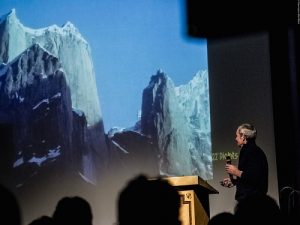
A young girl dressed in colorful mountain dress appeared on the side of the stage with a trophy she struggled to hold. It was obviously very heavy. Kay spoke in Italian, and then translated in English. Two other women representing the towns of Chamonix and Courmayeur gave separate speeches in French with Kay translating into English. A few lines that I heard from the speech were: “You have earned this award for a lifetime of commitment to bold, daring alpine ascents with commitment to the safety of your companions,” and “Mr. John Roskelley, you are awarded the Lifetime Achievement Award, the Piolets d’ Or.”
This was the “Golden Ice Axe,” the Piolets d’ Or trophy that millions of climbers in the world can only dream of winning. I was struck by the artistry and the construction of this trophy, a stunning piece of artwork that should be set in the middle of a room complete with viewing benches. An Oscar would make a nice door knob next to it. The main body of the trophy was vertical, one inch thick plate-glass shaped and cut into a mountain and set into a routed groove in a hardwood base. An artistic shaped modern ice axe made from molten metal was routed into the plate glass. The handle, or axe shaft, was the color of titanium. The adze, or cutting blade atop the handle, had a golden sheen. The golden plate on the hardwood base read: “Piolets d’Or Carriere. Walter Bonatti.” Loosely translated, this means the “The Golden Ice Axe, the calling in life, in the spirit of Walter Bonatti.” The girl holding the trophy seemed relieved to hand it over to John. Then the clapping began, and seconds later the audience rose to their feet and continued clapping. A standing ovation is a rare gesture in Europe, I am told.
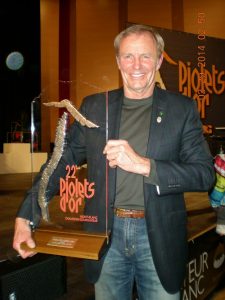
In my opinion, and the judgment of world alpinists, this is the highest honor that can be bestowed upon climbers; The Gold Medal, The Medal of Honor, the Academy Award for Best Performance, the Golden Globes, and American Idol, all rolled into one award for an athlete. In America, a climber could never make the back cover of a Muesli box, let alone a Wheaties Box, but in Europe, climbers are treated with the same acclaim as NBA or NFL heroes.
As Joyce Roskelley, John’s wife of 42 years, and kids Jordon and Jess clapped, the audience continued to stand and applaud. We all felt the deep respect shown for the “conquerors of futility.” I thought of all those hundreds of trips John and I took as teenagers. Fifty years ago starting out in the early 60s, John and I climbed the North Peak of Mt. Index, Mt. Baker and Mt. Rainier in a 3 ½ day weekend, including taking the time out to party half the night in Seattle. And we drove 1,300 miles round trip to climb Mt. Robson north of Jasper, all in three days, to get back in time for work. We knew the Alps and Himalayas were bigger. Years later, I snickered to myself when Seattle Seahawks superstars Jim Zorn and Steve Largent took three days to climb Mt. Rainier, saying “It was the hardest thing they ever did.”
Water was thicker than blood that night as I felt I was right up there on stage with my friend. It took 15 minutes for the photographers and journalists to dissolve so that I could get close enough to get a photo of John with his award. Journalists and photographers from all over Europe crowded around me, and not one was from the USA.
The final event of the evening presented the 2014 Piolets d’Or to Canadians Ian Welsted, Raphael Slawinsky and the superman from Switzerland, Ueli Steck. Welsted and Slawinky climbed a bold new route on K6 in Pakistan, and speed solo artist Ueli Steck climbed the South Face of Annapurna up and down, in the astounding time of 28 hours.
It was nearly 1 in the morning as we six senior citizens walked back to our hotel drunk with the warm spirit of the humanity of the event. The fraternity of the rope runs deep. This is what the world sorely needs. I thought of the words in the Piolets D’Or program: “Mountaineering, an incongruous activity in our societies, is a vehicle for the values of commitment and high performance, achieved with the deep respect for nature in one of its most powerful expressions: the high mountains. The performance is difficult to assess. The summit cannot be the only goal: the manner in which it is achieved is the main objective. While a major crisis destabilizes our society, a few men and women with no desire for celebrity or with forecasting any return on their investment, perpetuate the ideal of climbing summits by the most beautiful means possible, because the mountains exist and offer them this challenge by fair means.”
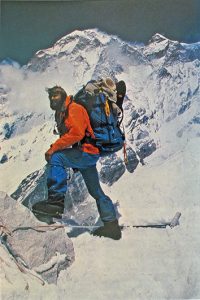
On a cold fall evening in 1964, John Roskelley and I started our careers in the mountains together. We envisioned mountaineers as athletic competitors focused on excellence. I have now witnessed my best friend inducted into the Inland Empire Hall of Fame, winning the National Underhill Award for Alpinism from the American Alpine Club, and now the international award for alpinism, The Lifetime Achievement Award and the Piolets d’Or.
That night I felt as if I had won it myself, but in the broader sense, we all won. //
By Chris Kopczynski










